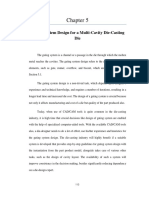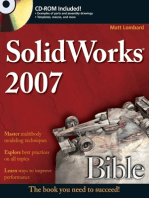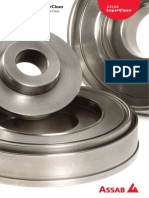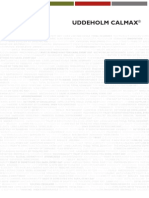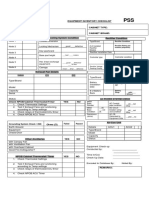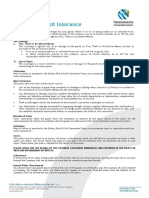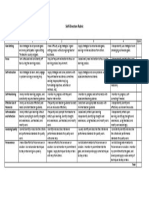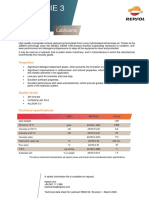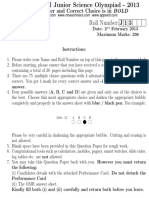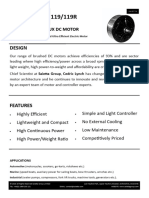Dievar D20140715
Dievar D20140715
Uploaded by
Keattikhun ChaichanaCopyright:
Available Formats
Dievar D20140715
Dievar D20140715
Uploaded by
Keattikhun ChaichanaOriginal Description:
Original Title
Copyright
Available Formats
Share this document
Did you find this document useful?
Is this content inappropriate?
Copyright:
Available Formats
Dievar D20140715
Dievar D20140715
Uploaded by
Keattikhun ChaichanaCopyright:
Available Formats
DIEVAR
UDDEHOLM
DIEVAR
DIEVAR
REFERENCE STANDARD
ASSAB DF-2
ARNE
ASSAB DF-3
AISI
WNr.
JIS
O1
(1.2510)
(SKS 3)
O1
(1.2510)
(SKS 3)
ASSAB XW-5
SVERKER 3
D6 (D3)
(1.2436)
(SKD 2)
ASSAB XW-10
RIGOR
A2
1.2363
SKD 12
ASSAB XW-41
SVERKER 21
D2
1.2379
SKD 11
D2
1.2379
SKD 11
ASSAB XW-42
CARMO
CARMO
1.2358
CALMAX
CALMAX
1.2358
CALDIE
CALDIE
ASSAB 88
SLEIPNER
ASSAB PM 23 SUPERCLEAN
VANADIS 23 SUPERCLEAN
(M3:2)
1.3395
SKH 53
ASSAB PM 30 SUPERCLEAN
VANADIS 30 SUPERCLEAN
(M3:2 + Co)
1.3294
SKH 40
ASSAB PM 60 SUPERCLEAN
VANADIS 60 SUPERCLEAN
VANADIS 4 EXTRA SUPERCLEAN
VANADIS 4 EXTRA SUPERCLEAN
VANADIS 6 SUPERCLEAN
VANADIS 6 SUPERCLEAN
VANADIS 10 SUPERCLEAN
VANADIS 10 SUPERCLEAN
VANCRON 40 SUPERCLEAN
VANCRON 40 SUPERCLEAN
ELMAX SUPERCLEAN
ELMAX SUPERCLEAN
(1.3292)
ASSAB 518
P20
1.2311
ASSAB 618
P20 Mod.
1.2738
ASSAB 618 HH
P20 Mod.
1.2738
ASSAB 618 T
P20 Mod.
1.2738 Mod.
ASSAB 718 SUPREME
IMPAX SUPREME
P20 Mod.
1.2738
ASSAB 718 HH
IMPAX HH
P20 Mod.
1.2738
NIMAX
NIMAX
MIRRAX 40
MIRRAX 40
VIDAR 1 ESR
VIDAR 1 ESR
UNIMAX
UNIMAX
CORRAX
CORRAX
ASSAB 2083
420 Mod.
H11
1.2343
SKD 6
420
1.2083
SUS 420J2
STAVAX ESR
STAVAX ESR
420 Mod.
1.2083 ESR
SUS 420J2
MIRRAX ESR
MIRRAX ESR
420 Mod.
POLMAX
POLMAX
RAMAX HH
RAMAX HH
ROYALLOY
ROYALLOY
420 F Mod.
PRODAX
ASSAB MM40
ALVAR 14
ALVAR 14
ASSAB 2714
ASSAB 8407 2M
ORVAR 2M
ASSAB 8407 SUPREME
ORVAR SUPREME
DIEVAR
DIEVAR
HOTVAR
HOTVAR
QRO 90 SUPREME
QRO 90 SUPREME
1.2714
SKT 4
1.2714
SKT 4
H13
1.2344
SKD 61
H13 Premium
1.2344 ESR
SKD 61
4340
1.6582
SNCM8
ASSAB 709
4140
1.7225
SCM4
ASSAB 760
1050
1.1730
S50C
ASSAB 705
ASSAB is a trademark of ASSAB Pacific Pte Ltd.
The information contained herein is based on our present state of knowledge and is intended to provide general notes on our products and their uses.
It should not therefore be construed as a warranty of specific properties of the products described or a warranty for fitness for a particular purpose.
Each user of ASSAB products is responsible for making its own determination as to the suitability of ASSAB products and services.
Edition D140715
DIEVAR
DIEVAR
Dievar is a hot work die steel specially developed by Uddeholm Tooling,
our steel mill in Sweden, to provide the best possible performance.
The chemical composition and the very latest in production technique
make the property profile outstanding. Dievar possesses a combination of
excellent toughness and very good hot strength, resulting in a superior hot
work die steel that have excellent resistance to heat checking and gross
cracking.
Dievar is suitable for high demand hot work applications like die casting,
extrusion and forging. The property profile also makes it a suitable choice
in other applications such as plastic moulding (e.g., to solve chipping/
cracking) and High Performance Steel.
Dievar offers the potential for significant improvements in die life, thereby
improving the tooling economy.
DIEVAR
General
Dievar is a high performance chromium-molybdenumvanadium alloyed hot work tool steel which offers a very
good resistance to heat checking, gross cracking, hot
wear and plastic deformation. Dievar is characterised by:
DIE CASTING
Excellent toughness and ductility in all directions
Good temper resistance
Good high-temperature strength
Excellent hardenability
Good dimensional stability throughout heat
treatment and coating operations
Type
Cr-Mo-V alloyed hot work tool steel
Standard
specification
None
Delivery
condition
Soft annealed to approx. 160 HB
Colour code
Yellow / Grey
Part
Aluminium / Magnesium alloys
Dies
44-50 HRC
EXTRUSION
Dievar is a premium hot work tool steel developed by
Uddeholm. It is manufactured utilising the very latest in
production and refining techniques. The Dievar
development has yielded a die steel with the ultimate
resistance to heat checking, gross cracking, hot wear
and plastic deformation. The unique properties profile
of Dievar makes it the best choice for die casting, forging
and extrusion.
Applications
Heat checking is one of the most common failure
mechanisms, e.g., in die casting and nowadays also in
forging applications. Dievars superior ductility yields the
highest possible level of heat checking resistance. With
Dievars outstanding toughness and hardenability, its
resistance to heat checking will be further improved.
If gross cracking is not a factor, then a higher working
hardness can be utilised (+2 HRC).
Part
Copper
alloys
Aluminium /
Magnesium alloys
Dies
46-52 HRC
46-52 HRC
44-52 HRC
Liners, dummy
blocks, stems
HOT FORGING
Regardless of the dominant failure mechanism (e.g.,
heat checking, gross cracking, hot wear or plastic
deformation), Dievar offers the potential for significant
improvements in die life as well as tooling economy.
Part
Dievar is the material of choice for the high demand die
casting, forging and extrusion industries.
Inserts
Steel / Aluminium
44-52 HRC
DIEVAR
Properties
The reported properties are representative of samples
which have been taken from the centre of a 610 x 203
mm bar. Unless otherwise indicated, all specimens were
hardened at 1025C, quenched in oil and tempered
2 + 2 hours at 615C to 451 HRC.
PHYSICAL PROPERTIES
Charpy V-notch impact toughness at elevated
temperatures
Short transverse direction.
Hardened and tempered to 44 - 46 HRC.
Temperature
At a hardness of approximately 45 HRC, the minimum
average unnotched impact ductility is 300 J in the short
transverse direction.
20C
Impact energy, J
400C
140
600C
120
Density
kg/m3
Modulus of elasticity
MPa
7800
7700
7600
210 000
180 000
145 000
45 HRC
100
80
47 HRC
60
Coefficient of
thermal expansion
per C from 20C
13.3 x 10 -6
12.7 x 10 -6
40
20
Thermal
conductivity
W/m C
31
50 HRC
32
50
100 150
200 250 300 350 400 450C
Testing temperature
MECHANICAL PROPERTIES
Temper resistance
Approximate tensile properties at room temperature,
tested in the short transverse direction.
Hardness
The specimens have been hardened and tempered to
45 HRC, and then held at different temperatures from
1 to 100 hours.
44 HRC
48 HRC
52 HRC
Tensile
strength, Rm
1480 MPa
1640 MPa
1900 MPa
Yield
strength, RP0.2
1210 MPa
1380 MPa
1560 MPa
Elongation, A 5
13 %
13 %
12.5 %
Reduction of
area, Z
55 %
55 %
52 %
Hardness, HRC
50
500C
45
550C
40
35
Approximate tensile properties at elevated
temperatures
600C
30
Short transverse direction, 451 HRC.
A5, Z
%
100
Rm, Rp0.2
MPa
2000
Z
1800
90
25
0.1
650C
10
100
Time, h
80
1600
70
1400
Rm
1200
60
50
1000
800
40
Rp0.2
30
600
20
400
200
10
A5
100
200
300
400
500
Testing temperature
600
700C
DIEVAR
Heat treatment
SOFT ANNEALING
QUENCHING
Protect the steel and heat through to 850C. Then cool
in the furnace at 10C per hour to 650C, then freely in air.
As a general rule, quench rates should be as rapid as
possible. Accelerated quench rates are required to
optimise tool properties specifically with regards to
toughness and resistance to gross cracking. However,
risk of excessive distortion and cracking must be
considered.
STRESS RELIEVING
The quenching media should be capable of creating a
fully hardened microstructure. Different quench rates
for Dievar are defined by the CCT graph as shown in
page 7.
After rough machining, the tool should be heated
through to 650C, holding time 2 hours. Cool slowly
to 500C, then freely in air.
High speed gas/circulating atmosphere
Vacuum (high speed gas with sufficient positive
pressure). An interrupted quench at 320450C is
recommended for distortion control, or when quench
cracking is a concern.
Martempering bath, salt bath or fluidised bed at
450550C
Martempering bath, salt bath or fluidised bed at
approx. 180200C
Warm oil, approx. 80C
HARDENING
Preheating temperature: 600900C. Normally a
minimum of two preheats, the first in the 600650C
range, and the second in the 820850C range. When
three preheats are used, the second is carried out
at 820C, and the third at 900C.
Austenitising temperature: 10001030C
Temperature
C
Soaking time
minutes
Hardness before
tempering
1000
30
522 HRC
1025
30
552 HRC
Note: Temper the tool as soon as its temperature
reaches 5070C.
TEMPERING
Choose the tempering temperature according to the
hardness required by reference to the tempering graph
below. Temper at least three times for die casting dies,
and two times for forging and extrusion tools. The tool
should be cooled to room temperature between the
tempers. The minimum holding time at tempering
temperature is 2 hours.
Soaking time = time at hardening temperature after the
tool is fully heated through.
Tempering in the range of 500550C is normally not
recommended, and it will result in a lower toughness.
Protect the tool against decarburisation and oxidation during
austenitising.
Tempering graph
Hardness, HRC
60
Hardness, grain size and retained austenite as
functions of austenitising temperature
Grain
size
ASTM Hardness, HRC
10 60
8
58
56
1000C
Retained austenite
1010
1020
1030
1040 1050C
Austenitising temperture
Temper
45
54
50
990 1000
50
Grain size
Hardness
52
Austenitising temperature
1025C
55
Retained austenite %
Retained austenite, %
40
35
30
25
Retained austenite
100
200
300
400
500
Tempering temperature (2 + 2h)
600
700C
DIEVAR
Effect of tempering temperature on room
temperature Charpy V-notch impact energy
DIMENSIONAL CHANGES DURING HARDENING
AND TEMPERING
Short transverse direction.
During hardening and tempering, the tool is exposed
to both thermal and transformation stresses. These
stresses will result in distortion. Insufficient levels of
machine stock may result in slower than recommended
quench rates during heat treatment. To reduce the
level of distortion, a stress relief is always recommended
bewteen rough and semi-finish machining, prior to
hardening.
Impact strength
60
Hardness HRC
60
50
50
40
40
Temper brittleness zone
30
30
20
20
10
10
200
300
400
500
600
For a stress relieved Dievar tool, a minimum machining
allowance of 0.3% is recommended to correct for
distortion during heat treatment with a rapid quench.
700C
Tempering temperature (2h + 2h)
CCT graph
Austenitising temperature 1025C. Holding time 30 minutes.
C
1100
Austenitising temperature 1025C
Holding time 30 minutes
1000
AC1 = 890C
900
AC1 = 820C
Carbides
800
Pearlite
700
600
500
Cooling Hardness
Curve No. HV 10
400
300
1
2
3
4
5
6
7
8
9
Bainite
MS
200
Mf
Martensite
100
1
10
100
1
1000
10
1.5
10 000
10
100 000
100
1000
1
0.2
1.5
15
280
1248
3205
5200
10400
20800
41600
Seconds
Minutes
10
90
681
627
620
592
566
488
468
464
405
T800-500
(sec)
600
100 Hours
Air cooling of
bars, mm
DIEVAR
Machining recommendations
The cutting data below are to be considered as guiding
values and as starting points for developing your own
best practice.
MILLING
Face and square shoulder milling
Condition: Soft annealed condition ~160 HB
TURNING
Cutting data
parameters
Rough
turning
Fine
turning
Fine
turning
150 - 200
Feed (f)
mm/r
0.2 - 0.4
0.05 - 0.2
0.05 - 0.3
2-4
0.5 - 2
0.5 - 2
P20 - P30
Coated
carbide
P10
Coated
carbide or
cermet
Carbide
designation
ISO
Turning
with HSS
Turning with cabide
Cutting speed
(vc)
m/min
Depth of cut (ap)
mm
Milling with carbide
Cutting data
parameters
200 - 250
Rough milling
Fine milling
Cutting speed
(vc)
m/min
130 - 180
180 - 220
Feed (f z)
mm/tooth
0.2 - 0.4
0.1 - 0.2
2-4
P20 - P40
Coated carbide
P10
Coated carbide
or cermet
15 - 20
Depth of cut (ap)
mm
Carbide
designation
ISO
End milling
High speed steel
Type of milling
Cutting data
parameters
Solid
carbide
Carbide
indexable
insert
High speed
steel
130 - 170
120 - 160
25 - 301
Feed (f)
mm/tooth
0.03 - 0.202
0.08 - 0.202
0.05 - 0.352
Carbide
designation
ISO
P20 - P30
DRILLING
High speed steel twist drill
Drill diameter
mm
Cutting speed (vc)
m/min
Feed (f)
mm/r
15 - 20 *
0.05 - 0.15
5 - 10
15 - 20 *
0.15 - 0.20
10 - 15
15 - 20 *
0.20 - 0.25
15 - 20
15 - 20 *
0.25 - 0.35
Cutting speed
(vc)
m/min
For coated HSS end mill, vc~ 4550 m/min
* For coated HSS drill, vc~ 3540 m/min
GRINDING
Wheel recommendation
Carbide drill
Type of grinding
Type of drill
Cutting data
parameters
Cutting speed
(vc)
m/min
Feed (f)
mm/r
1
2
Indexable
insert
Solid
carbide
180 - 220
120 - 150
60 - 90
0.05 - 0.252
0.10 - 0.252
0.15 - 0.252
Drill with replaceable or brazed carbide tip
Depending on drill diameter
Brazed
carbide1
Grinding wheel designation
Face grinding straight wheel
A 46 HV
Face grinding segments
A 24 GV
Cylindrical grinding
A 46 LV
Internal grinding
A 46 JV
Profile grinding
A 100 LV
DIEVAR
Machining recommendations
The cutting data below are to be considered as guiding
values and as starting points for developing your own
best practice.
MILLING
Face and square shoulder milling
Condition: Hardened and tempered to 451 HRC
TURNING
Cutting data
parameters
Turning with carbide
Rough turning
Fine turning
Cutting speed
(vc)
m/min
40 - 60
70 - 90
Feed (f)
mm/r
0.2 - 0.4
0.05 - 0.2
1-2
0.5 - 1
Depth of cut (ap)
mm
Carbide
designation
ISO
Milling with carbide
Cutting data
parameters
P20 - P30
Coated carbide
Rough milling
Fine milling
Cutting speed
(vc)
m/min
50 - 90
90 - 130
Feed (f z)
mm/tooth
0.2 - 0.4
0.1 - 0.2
2-4
P20 - P40
Coated carbide
P10
Coated carbide
or cermet
Depth of cut (ap)
mm
Carbide
designation
ISO
P10
Coated carbide or
cermet
End milling
Type of milling
Cutting data
parameters
DRILLING
Solid
carbide
Carbide
indexable
insert
High speed
steel
TiCN coated
60 - 80
70 - 90
5 - 10
Feed (f)
mm/tooth
0.03 - 0.201
0.08 - 0.201
0.05 - 0.351
Carbide
designation
ISO
P10 - P20
High speed steel twist drill (TiCN coated)
Drill diameter
mm
Cutting speed (vc)
m/min
Feed (f)
mm/r
4-6
0.05 - 0.10
5 - 10
4-6
0.10 - 0.15
10 - 15
4-6
0.15 - 0.20
15 - 20
4-6
0.20 - 0.30
Cutting speed
(vc)
m/min
Depending on radial depth of cut and cutter diameter
GRINDING
Wheel recommendation
Carbide drill
Type of grinding
Type of drill
Cutting data
parameters
Cutting speed
(vc)
m/min
Feed (f)
mm/r
1
2
Indexable
insert
Solid
carbide
Brazed
carbide1
60 - 80
60 - 80
40 - 50
0.05 - 0.252
0.10 - 0.252
0.15 - 0.252
Grinding wheel designation
Face grinding straight wheel
A 46 HV
Face grinding segments
A 36 GV
Cylindrical grinding
A 60 KV
Internal grinding
A 60 IV
Profile grinding
A 120 JV
Drill with replaceable or brazed carbide tip
Depending on drill diameter
DIEVAR
Surface treatment
NITRIDING AND NITROCARBURISING
Depth of nitriding
Nitriding and nitrocarburising result in a hard surface
layer which has the potential to improve resistance to
wear and soldering, as well as resistance to premature
heat checking. Dievar can be nitrided using gas or
plasma. It can also be nitrocarburised via gas or salt
bath process. The nitriding and nitrocarburising
temperature should be at least 2550C below the
highest previous tempering temperature, depending
upon the process time and temperature. Otherwise,
a permanent loss of core hardness, strength, and/or
dimensional tolerances may be experienced.
During nitriding and nitrocarburising, a brittle compound
layer, known as the white layer, may be generated. The
white layer is very brittle and may result in cracking or
spalling when exposed to heavy mechanical or thermal
loads. As a general rule, the white layer formation
must be avoided.
Process
Surface
hardness
HV0.2
Depth*
mm
Gas nitriding at
510C
10
30
1100
1100
0.16
0.22
Plasma nitriding
at 480C
10
1100
0.15
1100
0.13
1100
0.08
Nitrocarburising
in gas at
580C
in salt bath at
580C
*
Time
h
Depth of case = distance from surface where hardness is 50 HV0.2 over base
hardness
Electrical discharge machining
Following the EDM process, the applicable die surfaces
are covered with a resolidified layer (white layer) and a
rehardened and untempered layer, both of which are very
brittle and hence detrimental to die performance.
If EDM is used, the white layer must be completely
removed by grinding or stoning. After finish machining,
the tool should be given an additional temper at approx.
25C below the highest previous tempering temperature.
Nitriding in ammonia gas at 510C, or plasma nitriding at
480C, both result in a surface hardness of approx.
1100 HV0.2 . In general, plasma nitriding is the preferred
method because of better control over nitrogen
potential. However, careful gas nitriding can give
perfectly acceptable results.
The surface hardness after nitrocarburising in either gas
or salt bath at 580C is approx. 1100 HV0.2 .
10
DIEVAR
Welding
Further information
Welding of die components can be performed, with
acceptable results, as long as proper precautions are
taken during the preparation of the joint, the filler
material selection, the preheating of the die, the controlled
cooling of the die and the post weld heat treatment
processes. The following guidelines summarise the most
important welding process parameters.
Welding
method
TIG
MMA
Working
temp.1
325 - 375C
325 - 375C
Filler
material
QRO 90 TIG-WELD
DIEVAR TIG-WELD
QRO 90 WELD
475C
475C
Maximum
interpass
temp.2
Cooling
rate
Hardness
after
welding
For further information, i.e., steel selection, heat
treatment, application and availability, please contact our
ASSAB office nearest to you.
20 - 40C/h for the first 2 to 3 hours and
then freely in air
50 - 55 HRC
50 - 55 HRC
Heat treatment after welding
1
2
Hardened
condition
Temper at 25C below the original tempering temperature.
Soft
annealed
condition
Soft anneal the material at 850C
in protected atmosphere.
Then cool in the furnace at 10C per hour
to 600C, then freely in air.
Preheating temperature must be established throughout the die and must be
maintained for the entire welding process, to prevent weld cracking
The temperature of the tool in the weld area immediately before the second
and subsequent pass of a multiple pass weld. When exceeded, there is a
risk of distortion of the tool or soft zones around the weld.
11
DIEVAR
Relative comparison of ASSAB hot work die steels
QUALITATIVE COMPARISON OF CRITICAL DIE STEEL PROPERTIES
ASSAB grade
Temper
resistance
Hot yield
strength
Creep
strength
Coefficient
of thermal
expansion
Heat
conductivity
Ductility
ALVAR 14
ASSAB 8407 2M
ASSAB 8407 SUPREME
DIEVAR
HOTVAR
QRO 90 SUPREME
QUALITATIVE COMPARISON OF RESISTANCE TO DIFFERENT DIE FAILURES
ASSAB grade
ALVAR 14
ASSAB 8407 2M
ASSAB 8407 SUPREME
DIEVAR
HOTVAR
QRO 90 SUPREME
12
Heat
checking
Gross
cracking
Hot wear /
Erosion
Plastic
deformation
Corrosion (Al)
DIEVAR
13
DIEVAR
Case study
RESISTANCE TO HEAT CHECKING
Product
: Automotive housing
Work material : A380 Aluminium alloy
Work temp. : 690C
Tooling size : 406 x 508 x 508 mm
Die material : Premium H13 at 44-46 HRC vs DIEVAR 46-48 HRC
Background : Severe heat checking begins on Premium H13 at approximately 20,000 shots.
The customer wanted better die life.
Premium H13
DIEVAR
Comparison of Premium H13 and DIEVAR after 42,000 shots.
Premium H13
14
DIEVAR
DIEVAR
Ningbo
ASSAB Tooling Technology
(Ningbo) Co., Ltd.
Tel : +86 574 8680 7188
Fax: +86 574 8680 7166
info.ningbo@assab.com
Cikarang*
PT. ASSAB Steels Indonesia
Tel : +62 21 461 1314
Fax: +62 21 461 1306/
+62 21 461 1309
info.cikarang@assab.com
MALAYSIA
Kuala Lumpur - Head Office
ASSAB Steels (Malaysia) Sdn. Bhd.
Tel : +60 3 6189 0022
Fax: +60 3 6189 0044/55
info.kualalumpur@assab.com
Tel : +62 21 5316 0720-1
Jiangxi*
ASSAB Tooling (Dong Guan)
Co, Ltd., Jiangxi Branch
Tel : +86 769 2289 7888
Fax : +86 769 2289 9312
info.jiangxi@assab.com
15
Choosing the right steel is of vital importance. ASSAB engineers
and metallurgists are always ready to assist you in your choice of
the optimum steel grade and the best treatment for each application.
ASSAB not only supplies steel products with superior quality, we offer
state-of-the-art machining, heat treatment and surface treatment
services to enhance steel properties to meet your requirement in
the shortest lead time. Using holistic approach as a one-stop solution
provider, we are more than just another tool steel supplier.
ASSAB and Uddeholm are present on every continent. This ensures
you that high-quality tool steels and local support are available
wherever you are. Together we secure our position as the world's
leading supplier of tooling materials.
For more information, please visit www.assab.com
You might also like
- ESI ProCAST CourseDocument1 pageESI ProCAST CourseBashir AsadNo ratings yet
- Jet Cooling English Presentationv2Document21 pagesJet Cooling English Presentationv2susu22200050% (2)
- 2015 Nissan Service Maintenance GuideDocument70 pages2015 Nissan Service Maintenance GuideAhmed Almaghrby100% (2)
- Classification of Zinc Die Casting DefectsDocument20 pagesClassification of Zinc Die Casting DefectsAnshuman RoyNo ratings yet
- Runners, Gates and Feed System DataDocument23 pagesRunners, Gates and Feed System DataMariver LlorenteNo ratings yet
- Web043 Safe Reliable Die ClampingDocument40 pagesWeb043 Safe Reliable Die Clampingsinr100% (1)
- NADCA-High Temp DieDocument12 pagesNADCA-High Temp DiejalilemadiNo ratings yet
- YSS Die Casting Die MaterialDocument14 pagesYSS Die Casting Die MaterialVishal BalkwadeNo ratings yet
- 001 Plunger PDFDocument4 pages001 Plunger PDFKmilo GiraldoNo ratings yet
- Aluminium Die Casting Lubrication Technology and Trends en v1Document6 pagesAluminium Die Casting Lubrication Technology and Trends en v1g_nazario100% (1)
- 15ae307j - Aees - Unit 3Document41 pages15ae307j - Aees - Unit 3Aahana KhannaNo ratings yet
- Web072 Die Casting Modeling CapabilitiesDocument33 pagesWeb072 Die Casting Modeling CapabilitiessinrNo ratings yet
- VacuumDocument6 pagesVacuum03sri03No ratings yet
- 256412Document68 pages256412tabibkarim100% (1)
- Introduction in Alloys and Influence of Elements: Alloys and Melting 01 - Alloys - and - Melting - EN - Docx 1/13Document13 pagesIntroduction in Alloys and Influence of Elements: Alloys and Melting 01 - Alloys - and - Melting - EN - Docx 1/13luisA1923No ratings yet
- LPDC Flow SimulationDocument5 pagesLPDC Flow SimulationDavid JendraNo ratings yet
- Die CastingDocument263 pagesDie CastingRodri RocabadoNo ratings yet
- Porosity Defects On Die CastingDocument6 pagesPorosity Defects On Die Castinghasan_waqar2004No ratings yet
- Gating System Design For Casting Thin Aluminium Alloy (Al-Si) PlatesDocument10 pagesGating System Design For Casting Thin Aluminium Alloy (Al-Si) PlatesKhin Aung ShweNo ratings yet
- Die Casting Die Design - Runner, Gate, EtcDocument45 pagesDie Casting Die Design - Runner, Gate, EtcVig Pankaj100% (1)
- ALUMINIUMTECHNOLOGIES Week6Document164 pagesALUMINIUMTECHNOLOGIES Week6Sander Duque100% (2)
- Operator TrainingDocument38 pagesOperator TrainingluisA1923100% (1)
- Die Casting ProcessDocument35 pagesDie Casting ProcessgarciarodrigoNo ratings yet
- Magnesium Die CastingDocument3 pagesMagnesium Die CastingReza ArdhyatamaNo ratings yet
- Catalogo Die Cast DMEDocument24 pagesCatalogo Die Cast DMEkontacNo ratings yet
- Semi Solid & Squeeze CastingsDocument16 pagesSemi Solid & Squeeze Castingsvinny1978No ratings yet
- Cast Products 2Document72 pagesCast Products 2uzairmetallurgistNo ratings yet
- Study of Flow and Heat Transfer in High Pressure Die Casting Cooling ChannelDocument10 pagesStudy of Flow and Heat Transfer in High Pressure Die Casting Cooling ChannelSüleymanŞentürkNo ratings yet
- Reducing Die Soldering in Die Casting - NADCADocument33 pagesReducing Die Soldering in Die Casting - NADCAAntonio MagañaNo ratings yet
- Pro CASTDocument38 pagesPro CASTscience ki DuniyaNo ratings yet
- EC 515 Die Casting DefectsDocument197 pagesEC 515 Die Casting Defectsjuan jose pedrajoNo ratings yet
- Procast: Casting Simulation SuiteDocument12 pagesProcast: Casting Simulation SuiteKrishna PatelNo ratings yet
- Fundamentals of Metal CastingDocument45 pagesFundamentals of Metal CastingsuntharNo ratings yet
- AnyCasting - Software Intro - Die Casting PDFDocument46 pagesAnyCasting - Software Intro - Die Casting PDFSimon Risteski100% (1)
- NADCA Tolerances 2009Document44 pagesNADCA Tolerances 2009Pedjman GhaderiNo ratings yet
- HPDC Thermal Die CyclingDocument5 pagesHPDC Thermal Die CyclingSimon RisteskiNo ratings yet
- Die Casting 1106Document8 pagesDie Casting 1106sansagithNo ratings yet
- A Runner-Gate DesignDocument9 pagesA Runner-Gate DesignKetan ChhedaNo ratings yet
- The Effect of Jet-Cooling Application On Microstructural Properties of The Overheating Areas in High Pressure Die Casting PartsDocument4 pagesThe Effect of Jet-Cooling Application On Microstructural Properties of The Overheating Areas in High Pressure Die Casting PartsSüleymanŞentürkNo ratings yet
- High Integrity Die Casting - Imdc Dec 2013 Silafont®, Magsimal® Und Castasil®Document62 pagesHigh Integrity Die Casting - Imdc Dec 2013 Silafont®, Magsimal® Und Castasil®Giacomo Zammattio100% (1)
- Rheocasting of Aluminum 201Document56 pagesRheocasting of Aluminum 201Nahid LatonaNo ratings yet
- 2013-01 EM315 - EM311 CH02 Casting ProcessesDocument133 pages2013-01 EM315 - EM311 CH02 Casting ProcessesPrabu ÑÖnïtzNo ratings yet
- Casting DesignDocument39 pagesCasting DesignHirenkumar ShahNo ratings yet
- Die Casting Heat Treatment Process To Increase Strength Part 2Document6 pagesDie Casting Heat Treatment Process To Increase Strength Part 2itslowNo ratings yet
- ADSTEFAN Management Presentation - HPDCDocument21 pagesADSTEFAN Management Presentation - HPDCGeovanni Emmanuel Aguilar RangelNo ratings yet
- 2 PDC Tool Design TrainingDocument47 pages2 PDC Tool Design TraininganuranjandesignNo ratings yet
- Squeeze CastingDocument38 pagesSqueeze Castingjishnus100% (1)
- Pro CastDocument16 pagesPro CastMuhammad BilalNo ratings yet
- Design for additive manufacturing A Clear and Concise ReferenceFrom EverandDesign for additive manufacturing A Clear and Concise ReferenceNo ratings yet
- Calmax D20140711 PDFDocument12 pagesCalmax D20140711 PDFSinan YıldızNo ratings yet
- ASSAB PM 23 SuperClean Brochure English PDFDocument12 pagesASSAB PM 23 SuperClean Brochure English PDFnithiNo ratings yet
- Assab - XW 10 D20140711Document8 pagesAssab - XW 10 D20140711Orlando CellanNo ratings yet
- ASSAB PM 30 SuperClean Brochure EnglishDocument12 pagesASSAB PM 30 SuperClean Brochure EnglishnithiNo ratings yet
- Corrax D20140714Document8 pagesCorrax D20140714mj_davis04No ratings yet
- Asaab 8407 - 2MDocument11 pagesAsaab 8407 - 2MPrabath MadusankaNo ratings yet
- A New Die Material For Longer Service LifeDocument12 pagesA New Die Material For Longer Service LifeLuis SantosNo ratings yet
- PB Uddeholm Calmax EnglishDocument12 pagesPB Uddeholm Calmax EnglishxulubNo ratings yet
- Dac BDocument15 pagesDac BArief BudimanNo ratings yet
- PLDT Equipment Inventory Checklist PSSDocument2 pagesPLDT Equipment Inventory Checklist PSSGerald CorneliaNo ratings yet
- Belajar 4Document5 pagesBelajar 4Dina IrsalinaNo ratings yet
- R V Oliver & Ors (2002) EWCA Crim 2766Document11 pagesR V Oliver & Ors (2002) EWCA Crim 2766Henry TrumpingtonNo ratings yet
- N SFT GSP 001Document31 pagesN SFT GSP 001Juan Manuel Valencia RamirezNo ratings yet
- Optimised IPL Photocoagulation by Methaemoglobin Generation From Whole Blood - Laser EuropeDocument14 pagesOptimised IPL Photocoagulation by Methaemoglobin Generation From Whole Blood - Laser EuropeCaerwyn AshNo ratings yet
- Goods in TransitDocument3 pagesGoods in TransitsrinivasNo ratings yet
- Self Direction RubricDocument1 pageSelf Direction RubricCristine Mae NavarroNo ratings yet
- Range Catalogue 2010 enDocument80 pagesRange Catalogue 2010 enCou58couNo ratings yet
- YTG30TLV LeafletDocument1 pageYTG30TLV LeafletandriNo ratings yet
- Pirates of The Caribbean ImagineeringDocument21 pagesPirates of The Caribbean ImagineeringRaul ArrietaNo ratings yet
- SantroDocument289 pagesSantrosrawat_itproNo ratings yet
- Types of CommissionDocument5 pagesTypes of CommissionArnelson DerechoNo ratings yet
- Repsol Diesel Serie 3 10wDocument1 pageRepsol Diesel Serie 3 10wthrharsrgNo ratings yet
- Twi Cswip 3.1 Set-4b - 1Document5 pagesTwi Cswip 3.1 Set-4b - 1miteshNo ratings yet
- Doing Homework at 4amDocument5 pagesDoing Homework at 4amafeeotove100% (1)
- Heat Exchangers: Heat Transfer Lectures Chemical Engineering Department University of Technology, IraqDocument20 pagesHeat Exchangers: Heat Transfer Lectures Chemical Engineering Department University of Technology, IraqChemical EngineeringNo ratings yet
- Urban HydrologyDocument39 pagesUrban Hydrologyca rodriguez100% (1)
- Injso 2013Document22 pagesInjso 2013Aanchal MauryaNo ratings yet
- ĐẾ SỐ 11 HSG ANH 9Document13 pagesĐẾ SỐ 11 HSG ANH 9Ho OhNo ratings yet
- Non-Slip Deck CoatingDocument11 pagesNon-Slip Deck Coatingmanoj983@gmail.comNo ratings yet
- Drug Study ErythhropoietinDocument1 pageDrug Study ErythhropoietinAkiraMamoNo ratings yet
- This Study Resource Was: IB Biology - Mesocosm LabDocument2 pagesThis Study Resource Was: IB Biology - Mesocosm Lablilya roudaniNo ratings yet
- Design: Brushed Axial Flux DC MotorDocument2 pagesDesign: Brushed Axial Flux DC MotorAkshay DeolasiNo ratings yet
- HND Sector 3 Vol5Document800 pagesHND Sector 3 Vol5Richard Junior Homsi KueNo ratings yet
- Rti Act VDocument10 pagesRti Act VAppea EpdclNo ratings yet
- Mikeluna@momentgroup - PH: Code Description Unit Prices Amount QntyDocument2 pagesMikeluna@momentgroup - PH: Code Description Unit Prices Amount QntyHamid Alizadeh SagharlooNo ratings yet
- Lecture 7 Reforming and IsomerizationDocument5 pagesLecture 7 Reforming and IsomerizationMadhuri Gupta100% (1)
- Mineral Trioxide Aggregate MTA Solubility and Porosity WithDocument4 pagesMineral Trioxide Aggregate MTA Solubility and Porosity WithelnadaNo ratings yet
- Product CatalogueDocument39 pagesProduct Cataloguepawelstrzemiecznywp.plNo ratings yet























